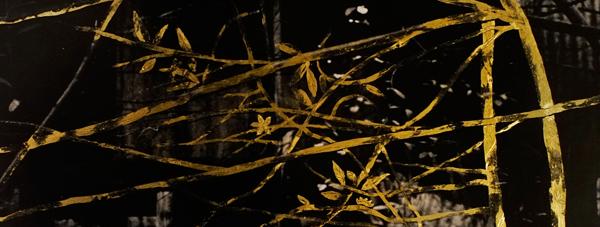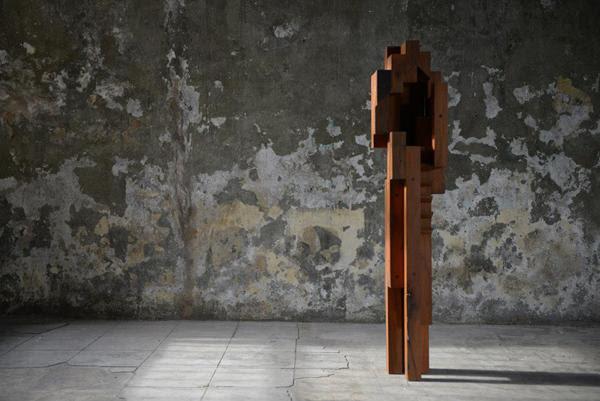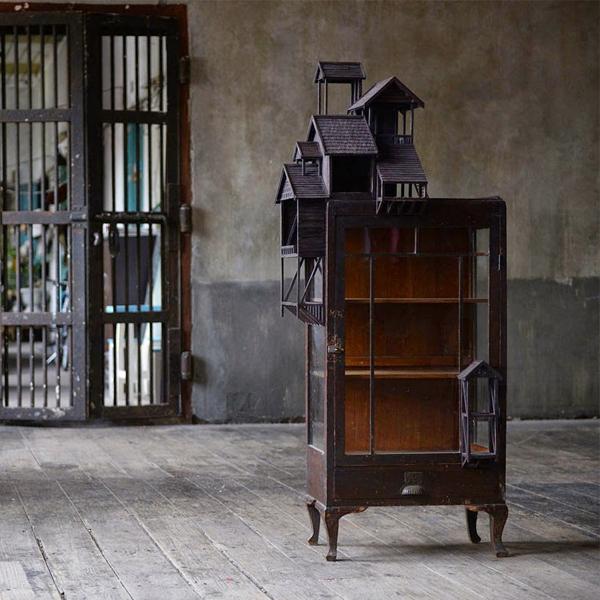นิทรรศการ "Genii Loci"

นิทรรศการ "Genii Loci" ผลงานโดย รัฐ เปลี่ยนสุข (Rush Pleansuk) จัดแสดงระหว่างวันที่ 17 ธันวาคม 2558 - 5 กุมภาพันธ์ 2559 และจะมีพิธีเปิดในวันที่ 17 ธันวาคม 2558 เวลา 18.00 น. ณ S gallery
"Genii Loci"
17th Dec - 5th Feb
EXHIBITION BY Rush Pleansuk
AT S GALLERYความหลังของอนาคต
I tend to live in the past because my life is there.กายที่สลายไปของบุคคลอันเป็นที่รัก ข้าวของเครื่องใช้ที่ยังเหลืออยู่ทำให้เรารู้สึกว่าเขายังคงมีตัวตนและเป็นเสมือนร่องรอยที่เขาได้ทิ้งไว้ระหว่างการเดินทาง
การถูกพรากจากความสุขอันเรียบง่ายของศิลปินในวัยเยาว์มาสู่สังคมคอนกรีตและการแข่งขันกับเวลาในเมืองทำให้เขามีความโหยหาธรรมชาติที่จากมา รัฐ เปลี่ยนสุขจึงมีใช้ชีวิตอยู่ในช่วงเวลาอันเป็นส่วนผสมของ อดีต(ความหลัง) ปัจจุบัน (ความเป็นจริง) อนาคต(ความฝัน) และนี่กลายเป็นพื้นฐานในการดำรงชีวิตตลอดจนการสร้างสรรค์ผลงานของเขาในเมืองหลวงที่ขับเคลื่อนด้วยความต้องการเชิงนามธรรมและรูปธรรมที่ตอบสนองปัจจัยหลักต่อการดำรงชีพของปุถุชน
เรารู้จักชื่อของ รัฐ เปลี่ยนสุข ครั้งแรกเมื่อผลงานของเขาถูกคัดเลือกให้ร่วมจัดแสดงภายในนิทรรศการ อันเป็นหนึ่งในกิจกรรมภายใต้เทศกาลวัฒนธรรมฝรั่งเศส หรือ La Fête อย่าง Designer’s Week ด้วยความรักในงานศิลปะและวิทยาศาสตร์ รัฐตัดสินใจศึกษาต่อในระดับอุดมศึกษาที่คณะสถาปัตยกรรมศาสตร์ มหาวิทยาลัยเกษตรศาสตร์ และสำเร็จการศึกษาในปี 2001 ในกระบวนการทำงานของรัฐ มักจะสะท้อนให้เห็นถึงรากเหง้าและจิตวิญญาณของผู้ใช้งานอยู่เสมอ
ความหลงใหลของรัฐ เปลี่ยนสุขที่มีต่อสถาปัตยกรรม ที่อยู่อาศัย องค์ประกอบที่กล่าวมาข้างต้นล้วนส่งอิทธิพลต่อการประดิษฐ์ผลงานจากฝีมือของศิลปินผู้นี้ โดยสร้างให้เป็นเสมือนสัญลักษณ์ที่คั่นกลางระหว่างคนเป็นและคนตาย อดีตและปัจจุบัน เป็นการรังสรรค์ทั้งสิ่งที่มองเห็นกับสิ่งที่มองไม่เห็น เป็นการเผยภาพลักษณ์ของความทรงจำที่หลบซ่อนตัวอยู่รัฐ
เริ่มต้นสร้างสรรค์ผลงานชุดนี้จากการเดินทางค้นหาและคัดสรรวัตถุดิบที่ซุกซ่อนความทรงจำของครอบครัวมาเป็นต้นทุนในการสร้างจิตวิญญาณให้กับผลงาน จากนั้นจึงใช้กรรมวิธีและการออกแบบเพื่อดึงเอาเรื่องราวของการเติบโตแห่งจิตวิญญาณจากข้าวของเครื่องใช้ที่ส่งผ่านจากรุ่นสู่รุ่นให้กลายมาเป็นรูปทรงที่งอกงามและจับต้องได้
ผลลัพธ์ที่ได้จึงมีเอกลักษณ์เฉพาะตัวซึ่งขึ้นอยู่กับวัสดุพื้นฐานที่นำมาใช้ สิ่งที่รัฐให้ความสำคัญไม่ได้มีเพียงรูปลักษณ์ที่สวยงามหรือประโยชน์ใช้สอยเท่านั้น แต่ยังรวมไปถึงการสอดแทรกมิติทางวัฒนธรรม และความทรงจำในวัยเด็กของเขาเข้าไปในชิ้นงาน
ผลงานศิลปะชุด Genii Loci มี รากศัพท์มาจากภาษาโรมัน หมายถึง วิญญาณที่คอยปกปักรักษาสถานที่ใดสถานที่หนึ่ง ในวัฒนธรรมเอเชียเชื่อว่าของใช้ที่ผูกพันและวัตถุที่ได้รับการสักการะบูชาจะเป็นที่สถิตย์ของวิญญาณและความเชื่อนี้ก็ยังคงตกทอดมาจนถึงปัจจุบัน ศิลปินได้นำความเชื่อด้านจิตวิญญาณนั้นมาแปรเป็นนามธรรมให้สามารถจับต้องได้
แรงบันดาลใจมาจากประเพณีการสร้างสิ่งปลูกสร้างและกำหนดให้วัตถุใดวัตถุหนึ่งเป็นตัวแทนที่ประทับของนามธรรมหรือที่เราเรียกว่า ‘วิญญาณ’ เพื่อจุดประสงค์ให้ปกปักษ์รักษา ดูแลผู้ที่ยังมีชีวิตอยู่ โดยถูกนำมาตีความใหม่ผ่านการยึดโยงเอาศาสตร์ด้านออกแบบ ประโยชน์ใช้สอย และคุณค่าเชิงศิลปะเข้ารวมกันได้อย่างลงตัวโดย
เนื้อหาของ Genii Loci เป็นการหยิบยกประเด็น ‘วัฏจักรชีวิต’ มานำเสนอ โดยแบ่งออกเป็น 4 ส่วน ไล่เรียงไปตั้งแต่
‘Body’ หรือ ‘เรือนแห่งกาย’ ที่แสดงให้เห็นถึงวัฏจักรแห่งการเติบโตและร่างกายมนุษย์
‘Sense’ หรือ ‘เรือนแห่งสัมผัส’ สะท้อนนัยเรื่องความไม่เที่ยงของชีวิตมนุษย์ โดยผิวสัมผัสของเรือนไม้นั้นไม่ต่างไปจากสภาวะสังขารที่สึกหรอไปตามกาลเวลา
‘Memory’ หรือ ‘เรือนแห่งความทรงจำ’ ศิลปินมีปรารถนาที่จะค้นหาจิตวิญญาณที่หลบซ่อนในวัตถุ Memoryเป็นการนำเอาความทรงจำที่ฝังอยู่ในข้าวของเครื่องใช้เก่ามาใช้เป็นวัตถุดิบเพื่อสร้างผลงานที่สามารถเติบโตและกลายสภาพมาเป็น ‘บ้านแห่งจิตวิญญาณ’ เฉกเช่นกับเห็ดโคนที่งอกขึ้นมาจากขอนไม้ ผลงานชิ้นนี้คือการถ่ายทอดให้เห็นถึงเรื่องราวความทรงจำของครอบครัวซึ่งถูกส่งผ่านจากรุ่นสู่รุ่น เพื่อใช้เก็บบรรจุความทรงจำ,ของใช้และรูปถ่ายของบุคคลอันเป็นที่รักที่ได้จากไป
‘Samsara’ หรือ ‘กาลเวลา’ บนวัฎจักรที่หมุนเวียนของฤดูกาลยังมีหลากหลายช่วงเวลาต้องเราต้องการให้หยุดนิ่ง ฤดูกาลเป็นดั่งฉากผ้าม่านบนเวทีที่บทละครแห่งชีวิตกำเนิดขึ้นและจบลง ผลงานศิลปะชุดนี้นำเสนอผ่านวัสดุทองคำเปลวอันเป็นตัวแทนของความขัดแย้งกันระหว่างความเปราะบางของแผ่นทองกับเนื้อทองที่เป็นสสารที่คงทน ถาวรการรวมตัวกันอย่างตั้งใจที่งดงามและละมุนละไมของกาลเวลา ความทรงจำ การสูญเสีย และการรำลึก ถูกนำมาใช้เป็นองค์ประกอบเพื่อให้เรารู้สึกใกล้ชิดและแปรค่าสิ่งอันเป็นนามธรรมเหล่านั้นผ่านงานศิลปะเพื่อให้สามารถจับต้องได้อีกครั้ง ผลงานที่เกิดขึ้นทั้งหมดเผยให้เราเห็นทั้งสภาพแวพล้อมที่ขาดหายและการเอาตัวรอดทางจิตใจในสภาพแวดล้อมอันสับสนวุ่นวาย และจะเป็นอีกหนึ่งบทสนทนาที่สื่อสารให้สังคมปัจจุบันหันกลับมาสนใจกับเรื่องราวของบรรพบุรุษและทำนุบำรุงรากเหง้าของตน
..............................................
"The past of the future
I tend to live in the past because my life is there".
Rush PleansukDespite the deterioration of physical body of a person we cling to, the personal belonging that left as the keepsakes will replace and represent of their existent in this world and as traces to our spiritual journey to another.
From the simple joys in childhood to his personal displacement to the concrete jungle, Rush has certainly come a long way. Currently caught up in the rat race in the big city, Rush is longing for a return to nature that he once left behind. The artist sees himself living in a time that’s a fusion of the past (background), present (reality) and future (dream). This world view forms the basis of his life and art that portrays the monstrous city in which one’s survival depends on having both abstract and material needs met.
Rush came to prominence as an artist when his artworks were selected for La Fête’s “Designer's Week”. Thanks to his love of art and science, Rush studied architecture at Kasetsart University and graduated in 2001. His architectural process has often searching from the cultural and spiritual root of his customers.
His passion with architectural and habitation has a direct impact on the way he creates his masterpieces, themselves symbols of the intermediate between living and the dead, past and present, invisible and visible. Through his art he reveals our memory in the tangible forms
Rush’s latest art collection titled “Genii Loci” is the result of his journey in search of raw materials mined from the ancestors memories. It’s the nostalgic memories of his childhood that have endowed his art with its spirit. His artworks tell the story of spiritual growth from these personal belongings that have been passed down through the generations and now turned into a variety of elegant tangible forms. Each piece has its own character depending on the story behind the derived materials used to created them.
Rush’s art celebrates not only the beauty of form and function, but it goes a step further by exhibiting a cultural dimension as evidenced by the embedding of his childhood memories in his art form.
“Genii Loci” is a Latin term for the protective spirit of a place. Some Asian cultures regard personal belongings and idols as the dwelling places of spirits, a belief that still resonates to this day. The artist is able to render this spiritual belief in physical form by drawing his inspiration from the Thai Traditionds assign as the dwelling place of its guardian spirit who is responsible for the safety of its occupants. Rush’s art is a reinterpretation of this traditional belief through the right blend of design, function and artistic value.
The Genii Loci collection – on the theme of “the cycle of life” – is divided into three parts: “Body, “Sense”, “Memory” and "Samsara".
"Body" focuses on the cycle of growth and the human body."
"Sense" portrays the transience of human life through the message that the texture of a wooden home, like that of human beings, is subject to decay through time.
"Memory" reflects the artist's desire to search for spirits dwelling in objects. “Memory” reflects the use of memories of people and places as embedded in a collection of old personal effects. These objects serve as the artist’s raw materials for creating works of art that can grow into the "homes of spirits" the same way mushrooms have sprouted up from a piece of wood. The artworks in this section bring back memories of his family and are used as a memory box to store the value keepsake from our love one.
"Samsara" (or “time”) represents the cycle of the seasons as well as the many moments in our life that we have wanted frozen. The changing of the seasons is like the rise and fall of a curtain in the theatre symbolising the beginning and the end of a real-life drama. The artist uses gold leaf to illustrate the stark contrast between the fragility of gold leaf and the durability of gold as a substance.The exhibition is an intentional integration of time, memory, loss and recollection that, through art, has transformed the abstract into the concrete and bridges us to relate to the past once again.
The exhibition portrays both a lost environment and an existing chaotic one in which people struggle to survive emotionally. The exhibition serves as a dialogue that attempts to turn our society on to the memory of our ancestors and the need to preserve our cultural roots.
For further information or reservations, please contact us at 093 5826588 or e-mail: sgallery.bangkok@gmail.com
ข่าวประชาสัมพันธ์ : S Gallery



